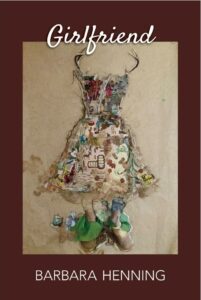Review by Geri Lipschultz
Emotionally and thematically resonant, Barbara Henning’s thirteenth book is a slim volume of sixty-nine entries, quasi-biographical and quasi-epistolary in nature. Even the title reflects a quality of compression and intimacy that characterizes these entries: “Girlfriend,” without the “s,” honors a feeling of one-ness that emerges, despite the number of seemingly disparate stories, each not even a full page, but poignant and startling, not to mention deftly crafted in a manner that does not call attention to the writing itself.
Henning began this project in the nineties but had to put it off for the stories to play themselves out. Some of her former friends were deceased, and some were not easy to find by way of social media and the telephone book. Yet many of the friendships were and are still in progress. So, while the time frames within the specific entries can range from the late 1940s to the present day, the chronological ordering, along with the stories themselves, keep the reader on track. Black and white photographs accompany the entries, and there is a tethering to time and place, utilizing the strategies of prose and poetry, along with Henning’s powerful lens.
Much of this is an assaying of friendship among girls and women—more narrative than analytical—the piecing together of a life, the forging of identity that is informed especially by mother loss. Many of these friendships reveal girls and women who, like Henning, are eking out lives without the benefit of maternal protection and without that tenderness, without that guidance, without that love.
The first entry, titled “Linda,” records the moments of “two infants in the arms of two sisters. Two little girls at a big dining room table writing notes in a secret language” (3).
The others follow with the salient details, the selected moments, evolving into interactions that are disturbing and subversive and recognizable to every woman and girl reading, scenes that expose households without a father or without a mother—not without violence and a pervasive lack of supervision: “huddled together in your bedroom, we stitched up the seams of my skirt, turned me into someone else” (5). Motherlessness is a pervasive theme. In the passage titled “Dot,” (each passage reflects the first name of the girlfriend whose story Henning tells), Henning writes: “Mine died under an oxygen tent. Yours in the basement when a camp stove exploded. Stepmothers soon to arrive” (6).
In addition to friends, Henning speaks of mentors, women writers she may have studied with, and some she may have known only through their art, such as Mina Loy, Julia Kristeva, Marguerite Duras, HD, and Emily Dickinson. She includes the quintessential motherless and suffering child, namely Cinderella. Of “Cinder Girl,” Henning writes that her own clothes were “hand-me-downs, not rags like yours” (6).
All of these passages are written in the second person.
Henning remembers, “When you grow up, dear, my mother said, you will have plenty of love and kisses. She meant a husband. I went for the plenty. In my bed in the attic by the hallway light, I read book after book, discovering utterly different worlds, but the problem was—how to get away” (6).
She writes to Cinderella: “Now I’m here with my words, my body and a big oak tree swaying in the wind. You, however, remain forever on the covers of many books, miraculously beautiful sitting by the side of your prince” (6).
As the book progresses, instead of hairstyles and husbands, the content shifts to matters artistic and intellectual. Of the writer, Diane DiPrima, who was a generation older, Henning writes, “we were also inventing our lives with as much personal and artistic freedom as possible. Not just the men. Us, too, with our strollers. A thread, a continuity” (68).
While what ostensibly greets the reader is a series of individual portraits and stories of friendships, what this charming book leaves you with—especially if you have traveled this life as a woman, and even more so if you happened to pass through NYC at this time in question—is a feeling of solidarity, along with the sense that you’ve just entered a gallery featuring a one-woman show. Through her portraits of others, you are led to the writer and her story. That connection between the plight of the motherless child, and the drive of both the writer and others she has drawn to her over the years, how they have come together working out their own passage into womanhood, in what may be seen as DIY lives that are artistic and communal in nature, with the potent urge to cast meaning and purpose into a life.
Girlfriend by Barbara Henning
Hanging Loose Press, 2025, $18.00
ISBN 9798991337700
Geri Lipschultz has published in Terrain, World Literature Today, Rumpus, Ms., Toast, New York Times, Black Warrior Review, College English, among others. Her work appears in Pearson’s literature anthology and in Spuyten Duyvil’s Wreckage of Reason II. Her one-woman show was produced in NYC by Woodie King, Jr. She is one of three poets who have written a children’s poetry book. That and a novel of hers will be published later this year.

